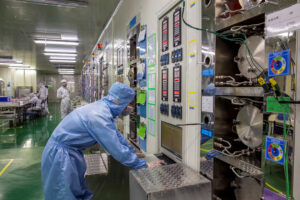THE PHILIPPINES is among six beneficiaries of a US-funded program to prepare the workforce and the regulatory environment ahead of the overhaul of US electronics supply chains under the CHIPS and Science Act.
Given funding of $13.8 million, Arizona State University (ASU) was chosen by the US to be the implementing partner for the Diversifying Semiconductor Supply Chains project.
“The Philippines is one of six strategic countries selected for this initiative, along with Costa Rica, Mexico, Panama, Indonesia, and Vietnam,” ASU said.
Running for two years, the project aims to improve the business environment, expand the skilled workforce, and refine regulatory frameworks to establish a resilient and diverse global assembly, testing, and packaging (ATP) supply chain in partner countries.
Earlier this year, US Commerce Secretary Gina M. Raimondo, said the US hopes to help the Philippines double its semiconductor ATP facilities.
“The key goal here for us is to support greater sector growth and encourage new semiconductor investments in the Philippines,” US Embassy Deputy Chief of Mission Y. Robert Ewing said.
“ASU programs are designed to expand semiconductor chip ATP operations in partner countries. And the program here has a goal of workforce development and reducing regulations that hinder ATP expansion,” he added.
Part of the program is the ITSI Workforce Accelerator, in which the ASU will give Filipino students the opportunity to obtain credentials in semiconductor packaging, processing, and testing.
“Those certificates and badges are offered not only by ASU but by other US universities as well, such as the University of Illinois, Purdue University, and others,” Jeffrey Goss, principal investigator of the ITSI Program at ASU, said.
“Students will have the opportunity to complete credentials through this. We’ve targeted initially in the Philippines around 6,000 students over the next two years,” he added.
Mr. Goss said ASU will also partner with the semiconductor industry association and Boston Consulting Group to work with policymakers to review industry rules.
“We are also working on an ATP National Playbook. The first draft will be published probably in December,” he said.
“That will outline opportunities and recommendations for policy and regulation reforms or changes in those policies or new policies and incentives to help the Philippines be more competitive in the region to attract investment,” he added.
Earlier this year, the Board of Investments announced a plan to produce 128,000 engineers for the semiconductor industry.
Trade Undersecretary and BoI Managing Head Ceferino S. Rodolfo said that the ITSI program will help the Philippines achieve this target.
“This will be in ATP first but eventually we will work on IC design … because we need to shore up first the advantage that we already have in ATP,” he said.
At a separate event, Advanced Manufacturing Workforce Development Alliance (AMDev) Program Chief-of-Party Danilo C. Lachica said the program has so far trained 5,478 individuals.
“That is as of yesterday because we ran a class in the Hermosa Ecozone (Industrial Park). The program’s goal was to train 300 for year 1 and another 1,000 in year 2,” Mr. Lachica said on the sidelines of a forum on Wednesday.
“We were able to grow the training base because of our training partners and their commitment,” he added.
AMDev is a five-year public-private partnership that aims to improve the capacity of the education system to meet changing industry requirements, particularly in Industry 4.0.
It was initiated by the United States Agency for International Development (USAID) and Unilab Foundation in 2022.
By the fifth year, the AMDev program is targeting to onboard 11,000 trainees.
Mr. Lachica said that the program also exceeded its year 2 targets in terms of advanced manufacturing institutes.
“That’s the goal over five years, and we are finishing our second year in September. So, we have three more years to go … and we are making good progress,” he said.
So far, the program has a network of four advanced manufacturing institutes, double the program’s second-year target of two such facilities. — Justine Irish D. Tabile
